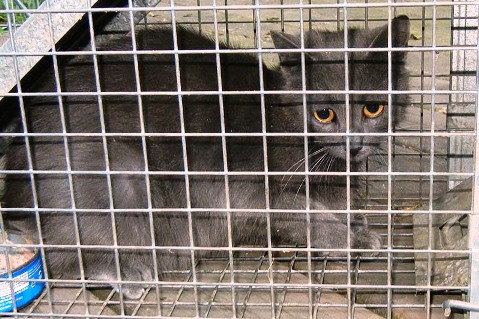The Kalamazoo County Humane Society says it is having success dealing with feral cats. They’re domestic pets who’ve gone wild and breed in large numbers. The Human Society has a regular spay and neuter program for pets “Operation Fix-it”. But every Thursday for the last year, staff veterinarians also sterilize feral and stray cats. WMUK’s Nancy Camden was there when 43 feral cats were brought in:
Thursday is Feral Cat Spaying and Neutering Day at Kalamazoo Humane Society. Several groups of volunteers live trap feral cats and bring them to the Kalamazoo Humane Society to be fixed in assembly-line style.
On this day, traps holding 43 feral cats with sheets over the top to calm them fill the Humane Society, which is not a sheltering facility. The cats will leave in the afternoon to recover in the homes of volunteers for a few days before being released. The rescue groups look for places where these cats will be welcome and get water, food and shelter like garages and barns. Most important: they won’t be reproducing.
In one year, the Kalamazoo Humane Society has sterilized nearly 1,600 feral cats. The trappers deal with all kinds of situations: hoarders, poor neighborhoods, and abandoned cats.
Staff veterinarian Sharon Wappel says, “We see a lot of ferals, which are truly the wild cat population that are unhandle-able; but we also see a lot of stray cats that are very friendly but just don’t have a home. We’ve probably seen Siamese or pure-bred Persians that are just out making a living on their own.”
Aaron Winters, the Executive Director of the Kalamazoo Humane Society, explains, “The Humane Society’s primary function has to do with pet population control, animal care and also education of pet owners. So often we get the question, ‘Isn’t it better if you just catch all of these cats and just take them and euthanize them?’ I’ve been in the business for 25 years and probably for nearly 100 years, the just picking and holding stray animals and disposing of them has not worked. Spaying and neutering and educating the owners and working on that even with feral cats, even if they go back out in the community, do more to reduce pet overpopulation.”
Gabby Dhaseleer is a vet tech on cat days. She explains that she is in the room where the anesthesia is started. The cats then move in the surgery suite where they are prepped and then, go into surgery. She says, “So, we are a well-oiled machine to go through this many. We have two vets on this day.”
Dr. Wappel explains that they have seen four-and-five-month-old pregnant cats, and that an unsprayed female can have thousands of progeny over her lifetime if not spayed. Dr. Merijo Jordan, the other vet, explains that it was a difficult, sad, decision but necessary to spay pregnant cats and euthanize their unborn kittens.
Some of the cats are adoptable but homes for them are scarce; others cats are truly wild and don’t belong in homes. Dhaseleer says that sterilizing cuts down on fighting by males and the number of kittens born to the females, and that helps cut down on the number of cats competing with other wild animals for food.
Winters says that the Feral Cat Program has been going on for a year and that monitored statistics of cats coming into shelters show improvement. He feels that a dollar invested in spaying and neutering feral cats saves five or ten dollars otherwise spent picking up, holding, euthanizing and disposing of them.
Fixed feral cats get rabies shots and the tips of their left ears are cut off to make them easily identifiable. There is no charge for the spaying or neutering of feral cats.

